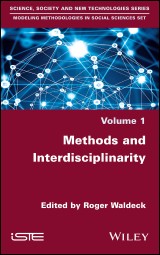Details
Methods and Interdisciplinarity
1. Aufl.
|
139,99 € |
|
| Verlag: | Wiley |
| Format: | EPUB |
| Veröffentl.: | 05.12.2019 |
| ISBN/EAN: | 9781119681533 |
| Sprache: | englisch |
| Anzahl Seiten: | 208 |
DRM-geschütztes eBook, Sie benötigen z.B. Adobe Digital Editions und eine Adobe ID zum Lesen.
Beschreibungen
Interdisciplinarity research results from a growing need for multi-perspective methods, and knowledge on complex and multifaceted objects of study. It is not simply scientific research that involves several disciplines, but ultimately, the aim is confronting this knowledge and – if possible – articulating it coherently. Using specific examples, Methods and Interdisciplinarity categorizes the different modes of interdisciplinarity and discusses the mechanisms of hybridization between them. On the one hand, the book shows how the same issue can be treated according to various points of view from several disciplines, which can give rise to complementary or even contradictory knowledge. On the other hand, it illustrates how methods from some disciplines make it possible to articulate the qualitative or quantitative approaches of others.
<p>Preface ix<br /><i>Roger WALDECK</i></p> <p><b>Chapter 1. Promoting and Experimenting with Interdisciplinarity </b><b>1<br /></b><i>Pierre LIVET</i></p> <p>1.1. Iméra project (<i>Institut méditerranéen d’études avancées –Mediterranean Institute of Advanced Studies</i>) 1</p> <p>1.2. Testing the typology of interdisciplinarity 4</p> <p>1.2.1. From formalisms to models and experiments 5</p> <p>1.2.2. Interacting with cross-disciplinary learning and instrumentation 6</p> <p>1.2.3. Interdisciplinarity of competing hypotheses and experiments 9</p> <p>1.2.4. Reflective intertemporal interdisciplinarity 10</p> <p>1.2.5. Interactions by combining disciplines 11</p> <p>1.2.6. Interdisciplinarity of reciprocity between contexts 13</p> <p>1.2.7. Transdisciplinarity between science and the reception of science 16</p> <p>1.2.8. Transdisciplinarity between arts and sciences 19</p> <p>1.3. Conclusion 20</p> <p><b>Chapter 2. Geography and Computer Science: Reasons for a Marriage, a Marriage of Reason? </b><b>23<br /></b><i>Denise PUMAIN</i></p> <p>2.1. Introduction 23</p> <p>2.2. Computers and numbers: quantifying geography 25</p> <p>2.2.1. Diversity of practices 26</p> <p>2.2.2. Epistemological changes driven by computer science rather than conceptual borrowings 27</p> <p>2.3. Simulation in geography and algorithmic thinking 31</p> <p>2.3.1. A difficult path 32</p> <p>2.3.2. Towards a win-win collaboration 35</p> <p>2.3.3. Geography in all digital objects 36</p> <p>2.4. Conclusion 38</p> <p>2.5. References 39</p> <p><b>Chapter 3. Conceptual Modeling and Multidisciplinary Dialogue </b><b>45<br /></b><i>Jean-Pierre MÜLLER</i></p> <p>3.1. Introduction 45</p> <p>3.2. Representation of theoretical discourses 47</p> <p>3.3. Disciplinary views on species 50</p> <p>3.4. Sectors and qualities 57</p> <p>3.5. Validation and communicability 61</p> <p>3.6. Conclusion 65</p> <p>3.7. References 66</p> <p><b>Chapter 4. Network Analysis: Linking Social and Ecological Dynamics </b><b>69<br /></b><i>Vanesse LABEYRIE, Sophie CAILLON, Matthieu SALPETEUR and Mathieu THOMAS</i></p> <p>4.1. Introduction 69</p> <p>4.1.1. Societies-environment interactions, what complex systems? 70</p> <p>4.1.2. Introduction to network formalism 72</p> <p>4.2. Examples of applications to the study of interactions between societies and the environment 76</p> <p>4.2.1. Crop seed circulation and social networks 77</p> <p>4.2.2. Circulation of knowledge and structuring of know-how 87</p> <p>4.3. Discussion: a necessary link between the quantitative and the qualitative 93</p> <p>4.4. References 96</p> <p><b>Chapter 5. Interdisciplinarity and VUCA </b><b>99<br /></b><i>Roger WALDECK, Sophie GAULTIER LE BRIS and Siegfried ROUVRAIS</i></p> <p>5.1. Introduction 99</p> <p>5.2. Decision theory 100</p> <p>5.3. An interdisciplinary look at VUCA 102</p> <p>5.3.1. VUCA definitions in management 102</p> <p>5.3.2. Definitions from decision theory 104</p> <p>5.4. Discussion 112</p> <p>5.5. References 115</p> <p><b>Chapter 6. Learning Methodology for VUCA Situations </b><b>117<br /></b><i>Sophie GAULTIER LE BRIS, Siegfried ROUVRAIS and Roger WALDECK</i></p> <p>6.1. Engineering education & training and highly reliable organizations 117</p> <p>6.2. Issues at stake 119</p> <p>6.2.1. VUCA phenomenon classes 121</p> <p>6.3. Theoretical framework of organizational reliability 125</p> <p>6.3.1. Running highly reliable and actionist organizations 125</p> <p>6.3.2. Selected models 127</p> <p>6.4. Cross-disciplinary decision-making skills: design-oriented research 128</p> <p>6.4.1. Research methodology for learning 129</p> <p>6.4.2. From model to reality 130</p> <p>6.4.3. Learning outcomes 133</p> <p>6.5. Conclusion 136</p> <p>6.6. Appendix: level of experience and feedback from IMTA students 138</p> <p>6.7. References 144</p> <p><b>Chapter 7. Approaches to and Applications of Graphemics </b><b>149<br /></b><i>Yannis HARALAMBOUS</i></p> <p>7.1. Writing and linguistics 149</p> <p>7.2. Spectral decomposition to the rescue of linguistics 154</p> <p>7.3. Application in biometrics 159</p> <p>7.4. Application in steganography 162</p> <p>7.4.1. Steganographic approach to Greeklish 163</p> <p>7.4.2. Steganographic method: evaluation 165</p> <p>7.5. Conclusion 167</p> <p>7.6. References 167</p> <p>List of Authors 171</p> <p>Index 173</p>
Roger Waldeck is Associate Professor at IMT Atlantic and a member of the Laboratoire d?Economie et de Gestion de l?Ouest (LEGO), France. His current research focuses on modeling methodologies for complex social systems.



















